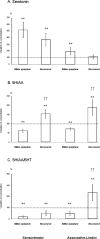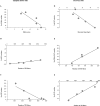Behavioral recovery in MPTP-treated monkeys: neurochemical mechanisms studied by intrastriatal microdialysis
- PMID: 18799689
- PMCID: PMC6671121
- DOI: 10.1523/JNEUROSCI.3465-08.2008
Behavioral recovery in MPTP-treated monkeys: neurochemical mechanisms studied by intrastriatal microdialysis
Abstract
Parkinson's disease (PD) patients express motor symptoms only after 60-80% striatal dopamine (DA) depletion. The presymptomatic phase of the disease may be sustained by biochemical modifications within the striatum. We used an appropriate specific 1-methyl-4-phenyl-1,2,3,6-tetrahydropyridine (MPTP) monkey model (Mounayar et al., 2007) to study the compensatory mechanisms operating in recovery from PD motor symptoms. We assessed the levels of DA and its metabolites (DOPAC, homovanillic acid), GABA, glutamate (Glu), serotonin (5-HT) and its metabolite (5HIAA) by repeated intracerebral microdialysis in awake animals before exposure to MPTP during full expression of the motor symptoms induced by MPTP and after recovery from these symptoms. Measurements were obtained from two functionally and anatomically different striatal areas: the associative-limbic territory and sensorimotor territory. Animals with motor symptoms displayed an extremely large decrease in levels of DA and its metabolites and an increase in Glu and GABA levels, as reported by other studies. However, we show here for the first time that serotonin levels increased in these animals. We found that increases in DA levels in the sensorimotor and/or associative-limbic territory and high levels of 5-HT and of its metabolite, 5HIAA, were associated with recovery from motor symptoms in this model. Determining whether similar changes in DA and 5-HT levels are involved in the compensatory mechanisms delaying the appearance of motor symptoms in the early stages of PD might make it possible to develop new treatment strategies for the disease.
Figures






Similar articles
-
Dietary restriction affects striatal glutamate in the MPTP-induced mouse model of nigrostriatal degeneration.Synapse. 2005 Aug;57(2):100-12. doi: 10.1002/syn.20163. Synapse. 2005. PMID: 15906381
-
Effects of dopamine and serotonin antagonist injections into the striatopallidal complex of asymptomatic MPTP-treated monkeys.Neurobiol Dis. 2012 Oct;48(1):27-39. doi: 10.1016/j.nbd.2012.06.002. Epub 2012 Jun 21. Neurobiol Dis. 2012. PMID: 22728661
-
alpha-Synuclein- and MPTP-generated rodent models of Parkinson's disease and the study of extracellular striatal dopamine dynamics: a microdialysis approach.CNS Neurol Disord Drug Targets. 2010 Aug;9(4):482-90. doi: 10.2174/187152710791556177. CNS Neurol Disord Drug Targets. 2010. PMID: 20522009 Review.
-
Role of nitric oxide in modulating the release of dopamine, glutamate, and GABA in striatum of the freely moving rat.Brain Res Bull. 1998;45(3):275-9. doi: 10.1016/s0361-9230(97)00402-4. Brain Res Bull. 1998. PMID: 9510419
-
Microdialysis and the neurochemistry of addiction.Pharmacol Biochem Behav. 2008 Aug;90(2):261-72. doi: 10.1016/j.pbb.2007.09.001. Epub 2007 Sep 12. Pharmacol Biochem Behav. 2008. PMID: 17928041 Free PMC article. Review.
Cited by
-
Quantification of Non-Motor Symptoms in Parkinsonian Cynomolgus Monkeys.Brain Sci. 2023 Aug 1;13(8):1153. doi: 10.3390/brainsci13081153. Brain Sci. 2023. PMID: 37626508 Free PMC article.
-
The temporary and accumulated effects of transcranial direct current stimulation for the treatment of advanced Parkinson's disease monkeys.Sci Rep. 2015 Jul 29;5:12178. doi: 10.1038/srep12178. Sci Rep. 2015. PMID: 26220760 Free PMC article.
-
The Neurodegenerative Elderly Syndrome (NES) hypothesis: Alzheimer and Parkinson are two faces of the same disease.IBRO Neurosci Rep. 2022 Sep 26;13:330-343. doi: 10.1016/j.ibneur.2022.09.007. eCollection 2022 Dec. IBRO Neurosci Rep. 2022. PMID: 36247524 Free PMC article. Review.
-
Chronic MPTP administration regimen in monkeys: a model of dopaminergic and non-dopaminergic cell loss in Parkinson's disease.J Neural Transm (Vienna). 2018 Mar;125(3):337-363. doi: 10.1007/s00702-017-1774-z. Epub 2017 Aug 31. J Neural Transm (Vienna). 2018. PMID: 28861737 Free PMC article. Review.
-
Evidence for cross-hemispheric preconditioning in experimental Parkinson's disease.Brain Struct Funct. 2018 Apr;223(3):1255-1273. doi: 10.1007/s00429-017-1552-6. Epub 2017 Nov 4. Brain Struct Funct. 2018. PMID: 29103154 Free PMC article.
References
-
- Agid Y, Javoy-Agid F, Ruberg M. Biochemistry of neurotransmitters in Parkinson's disease. In: Marsden CD, Fahn S, editors. Movement Disorders. London: Springer/Butterworth; 1987. pp. 166–230.
-
- Benloucif S, Galloway MP. Facilitation of dopamine release in-vivo by serotonin agonists: studies with microdialysis. Eur J Pharmacol. 1991;200:1–8. - PubMed
-
- Bernheimer H, Birkmayer W, Hornykiewicz O, Jellinger K, Seitelberger F. Brain dopamine and the syndromes of Parkinson and Huntington. Clinical, morphological and neurochemical correlations. J Neurol Sci. 1973;20:415–455. - PubMed
-
- Bezard E, Boraud T, Bioulac B, Gross CE. Compensatory effects of glutamatergic inputs to the substantia nigra pars compacta in experimental parkinsonism. Neuroscience. 1997;81:399–404. - PubMed
-
- Bezard E, Jaber M, Gonon F, Boireau A, Bloch B, Gross CE. Adaptative changes in the nigrostriatal pathway in response to increased 1-methyl-4-phenyl-1,2,3,6-tetrahydropyridine-induced neurodegeneration in the mouse. Eur J Neurosci. 2000;12:2892–2900. - PubMed
Publication types
MeSH terms
Substances
LinkOut - more resources
Full Text Sources
